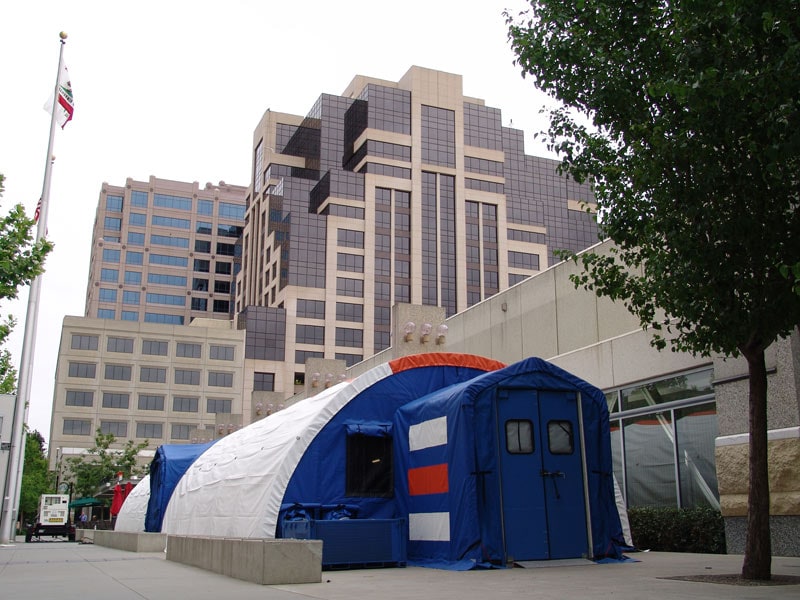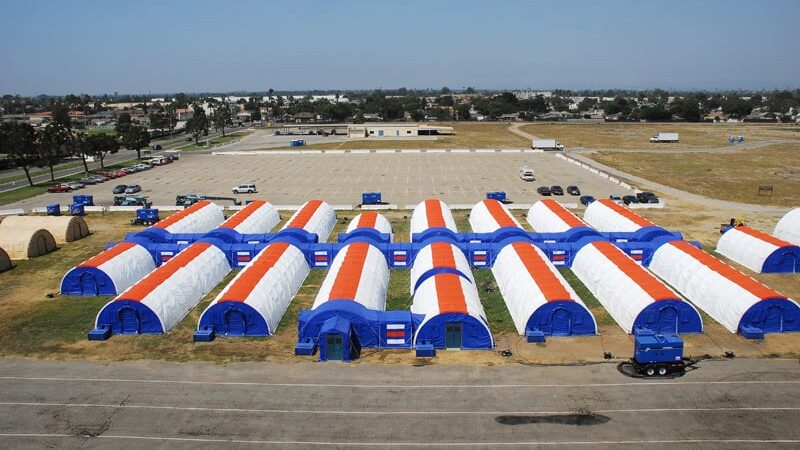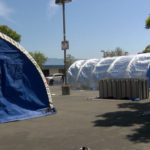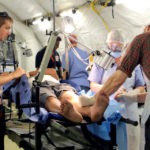BLU-MED Medical Facilities and Mobile Field Hospitals vs. Expandable Hospital Containers
When man-made or natural disasters require an immediate emergency response, deployable medical facilities allow hospitals, first responders, governments, and relief organizations to quickly respond with medical facilities capable of providing basic to advanced-level care …when and where needed™.
Whether it is part of a state-level emergency preparedness plan, hospitals establishing an alternate emergency operation center (AEOC) or hospital surge capacity in the wake of a natural disaster, or having a fully-equipped field hospital on the shelf and ready to deploy to any location in the world at a moment’s notice – when it comes to saving lives, time is of the essence.
The World Health Organization (WHO) says that field hospitals used in response to a disaster should be fully operational within 24 hours of the incident and have the capability and capacity to provide an appropriate level of medical care. The level of medical support needed can be as minimal as a single shelter for triage and first aid to a maximalist approach that mobilizes considerable resources including turnkey field hospitals capable of providing tertiary level medical care, personnel, medical equipment and evacuation assets.
The WHO advises aid organizations to consider the setup time, costs associated with transportation and logistics, as well as the maintenance requirements (and cost) when investing in deployable medical facilities.
While there are many types of mobile medical facilities, including fixed systems like medical trailers and hospital containers, this comparison will focus on expandable, hard-walled hospital intermodal (ISO) containers versus mobile field hospitals using rapidly deployable and engineered fabric structures.
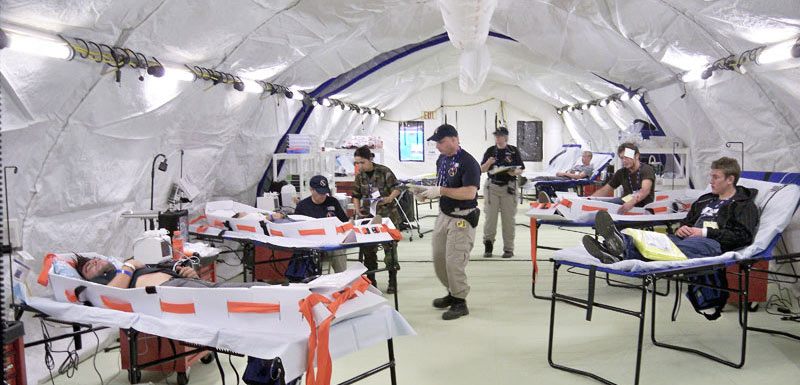
Mobile Field Hospitals and Medical Facilities Using Engineered Fabric Structures
BLU-MED Response Systems® (BLU-MED) is the world’s premier manufacturer of engineered fabric structures designed to provide a clean, safe, and scalable environment to support all levels of medical and health care needs, including isolation and treatment facilities for infectious diseases, hospital staff housing, mobile command centers, and more.
Reduce Logistics and Transportation Costs with Fabric Medical Shelters
Fabric medical shelters from BLU-MED can be packed and transported in a much smaller and more compact cube – one-tenth the volume of expandable hospital containers. This makes the logistics for deploying mobile field hospitals or medical shelters made using engineered fabric structures to remote locations via aircraft, boats, rail, or trucks much more manageable as well as reducing overall transportation costs.
Below is a comparison of a single BLU-MED medical shelter packed into a small, reusable storage container versus a 3-to-1 expandable hospital ISO container.
- A single BLU-MED reusable, roto-mold container with dimensions of 8.53’ long x 3.28’ wide x 3.94’ tall can hold an entire 20’ wide x 32.5’ long BLU-MED medical shelter providing 650 square-feet of floor space.
- A single 20’ 3-to-1 expandable hospital container measures 19.83’ long x 8.00’ wide x 9.50’ tall (high cube 20-foot container). When expanded, there is approximately 375 square-feet of floor space.
BLU-MED medical facilities can be transported in a much smaller storage container and provide nearly two-times the interior floor space compared to expandable hospital ISO containers.
Mobile Medical Facilities to Support Short-Term or Ongoing Medical Operations
Mobile hospitals and medical facilities from BLU-MED offer the unmatched ability to quickly provide a scaled medical response to meet the immediate, short-term, or support ongoing medical operations. BLU-MED mobile field hospitals have been used around the world and in locations where:
- Geographical factors such as terrain and road conditions make it difficult to deploy trailer or ISO container-based hospitals by road to patients with medical needs in a timely fashion.
- Medical infrastructure is either non-existent, has deteriorated or been compromised as a result of man-made or natural disasters.
- In response to small- and large-scale emergencies or mass casualty situations.
- Deployed in conflict zones.
Medical facilities from BLU-MED can be reconfigured and adapted to meet the ever-changing needs of providing medical care or specialized treatment following a disaster or emergency. Unlike specialized medical trailers and expandable hospital containers that have ‘fixed’ medical equipment intended to meet specific medical needs, a BLU-MED medical shelter can be customized with an assortment of modular health care packages, medical equipment, and supplies that seamlessly integrate with our medical shelter systems but are not fixed to the fabric structure. This allows the same BLU-MED medical facility to be reconfigured for mobile emergency rooms, mobile trauma centers, command and control centers, medical facilities for hospital surge capacity, as well as portable outpatient clinics.
Engineered for Rugged Durability and Virtually Maintenance Free Mobile Hospitals
BLU-MED medical facilities and mobile field hospitals are designed, engineered, and made in the USA, using the highest quality materials, strict quality control processes, and utilizing lean manufacturing techniques to reduce waste. The end result is a mobile medical solution that can be deployed to any location in the world and provide life-saving support.
In addition to being rapidly deployed to the scene of a disaster or used to provide medical services in a remote part of the world, BLU-MED medical shelters are engineered for durability. Each medical shelter system is tested according to mil-spec tests, both in the field and by government and independent laboratory testing facilities.
BLU-MED medical facilities undergo rigorous setup and strike testing, to ensure our modular building systems can withstand the demands of 100+ setup cycles without mechanical failure. All BLU-MED medical structures utilize a fabric membrane tensioned over a metal frame system. The fabric membrane is made using a proprietary blend of materials that will not rot, is mold and mildew resistant, UV stabilized (not coated) for prolonged exposure to high solar loads, offers a greater abrasion resistance compared to other PVC (polyvinyl chloride) or PE (polyethylene) based covers, has been tested to withstand temperatures as low as -80˚F to +130˚F, and exceeds the fire safety requirement outlined in the California Code of Regulations for membrane structures.
The high-strength frame systems of BLU-MED medical shelters, depending on the medical shelter size and model, can be made of galvanized steel or lightweight aircraft-grade aluminum. All metal frame components are powder-coated in-house to provide a superior level of protection against corrosion from rust, salt air, oxidation, and humidity.
All BLU-MED medical shelters can be securely anchored to virtually any level surface, including wood platforms, asphalt, and concrete. Optional sub-flooring is available for deployments to locations with gravel, dirt, or grass surfaces.
Once setup, a BLU-MED mobile field hospital is virtually maintenance free, allowing first responders, governments, and aid organizations to focus on the medical mission.
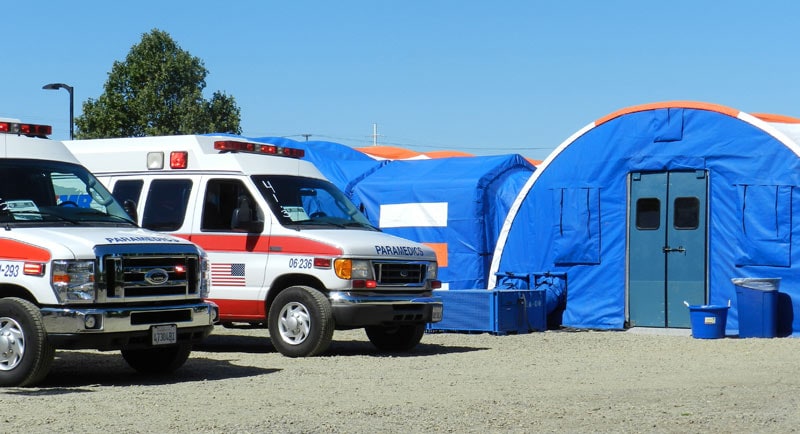
What are Expandable Hospital Containers?
Expandable hospital containers have similar handling requirements to shipping containers and are considered ‘intermodal’, meaning that different modes of transportation can move them, such as rail, ship, truck, or airlift. As the name suggests, expandable hospital containers employ a design where the sides of the container fold out to create a larger interior space. The expanding sides of the hospital container are typically made of fabric or metal.
Logistical Issues of Using Expandable Medical Containers
Expandable medical containers are occasionally used by relief agencies, governments, militaries, and first responders to deploy to areas with specific medical needs. Despite the advantage of being largely self-contained, the packaged footprint of 3-to-1 expandable hospital containers is at best, one-third of the fully deployed size. This means more and larger vehicles (or aircraft) are required for transporting a hospital which incorporates ISO containers, versus a hospital constructed of fabric structures.
Given that disasters can occur at any time and any place, the logistics with sourcing and securing a large volume of flatbed trucks, specialized loaders, cranes or heavy lifting equipment, and large transport aircraft to transport a mobile hospital which incorporates ISO containers is typically more expensive compared to the transportation efficiency or reduced cost of shipping a mobile field hospital made using engineered fabric structures. In addition, the equipment necessary for lifting, loading and transporting these large containers must be available at each transition point along the route of transportation, from point of origin to final setup site. This is rarely the case during disaster response situations, particularly in remote locations and during the initial stages of a disaster event.
Limitations of Hospital Containers
ISO containers are limited by their standardized size — 8 feet wide and either 20 or 40 feet in length. Despite having folding sides, that expand outward to create a larger interior space, steel or aluminum containers do not have the flexibility that fabric structures offer. Medical shelters, like those from BLU-MED can easily be complexed to create a large mobile field hospital. The medical shelters are made from tensioned fabric structures, as are the connecting hallways, corridors, and vestibule entries. Hospitals made from shipping containers or expandable hospital containers require heavy equipment and loaders for precise placement to meet the same complex capability of engineered fabric structures. Some hospital container systems rely on fabric structures to provide the necessary hallway and corridor space needed to connect multiple hospital containers to create a self-contained field hospital.
And the Award Goes To…
Medical shelter systems and mobile field hospitals made using engineered fabric structures from BLU-MED allow disaster response and emergency management agencies, first responders, non-governmental organizations (NGOs), governments, and hospitals to quickly and effectively respond to humanitarian crises anywhere in the world.
With medical shelters capable of being setup in less than 15 minutes, disaster response times can be significantly less than the 24-hour response time recommended by WHO.
One last comparison! A 40-foot trailer is capable of transporting two expandable hospital containers, providing a total of 753.48 square-feet of floor space. The same 40-foot trailer can deliver a 12-shelter BLU-MED medical facility, providing 9,000 square-feet of floor space (with vestibules and connecting hospital corridors)! Fabric medial shelters from BLU-MED are the clear winner.
Contact us today to discuss how a BLU-MED medical shelter or mobile field hospital can benefit your emergency response or hospital preparedness plan.
Call toll free (USA and Canada): +1-888-680-7181
All other and international calls: +1-425-739-2795
Email: inforeq@blu-med.com
Use our online contact form
